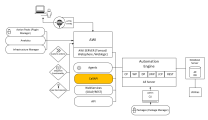Installing the CallAPIs
As an administrator, you install the CallAPIs to trigger processes in an AE system from external systems by using the Automation Engine scripting language. You can use them either with your own program, or with a utility. A CallAPI is limited to 32000 characters, as are all scripts in the Automation Engine scripting language.
Tip: Consider using the REST API instead of the CallAPI in some cases. The REST API has a /scripts endpoint that covers Call API functions. The advantages are that you do not need to use several Service Manager services if you are connecting your own system(s) to several AE systems and/or clients. Also, the REST API does not require a user login whenever it is called. This is very helpful in situations where the workload is high. For more information, see REST API.
Important! As of version 21, the Java and SAP CallAPIs use TLS/SSL to connect to the Automation Engine. They establish a connection to the new Java communication process (JCP)and use trusted certificates to prove their identity to other communication partners. All other CallAPIs still connect to the CP.
More information:
For more information about the different certificate types and for detailed instructions on how to create and use them, see What Kind of Certificates Should I Use for Automic Automation v21.
In Automic Automation Kubernetes Edition, CallAPIs establish a connection to a TCP load balancer. The address of the load balancer must be defined on both sides: the Automation Engine and the CallAPI. The only exceptions are the CallAPIs for Java and SAP, which must be upgraded to use TLS/SSL to connect to the Automation Engine. These two CallAPIs establish a connection with the Java communication process (JCP) through an HTTPS load balancer.
More information:
System Overview
Click the image to expand it.
This section includes the following pages:
Note: Only a subset of the components listed is available for Automic Automation Kubernetes Edition. For more information, see Installing the Additional Components - Container-Based Systems.
See also:
